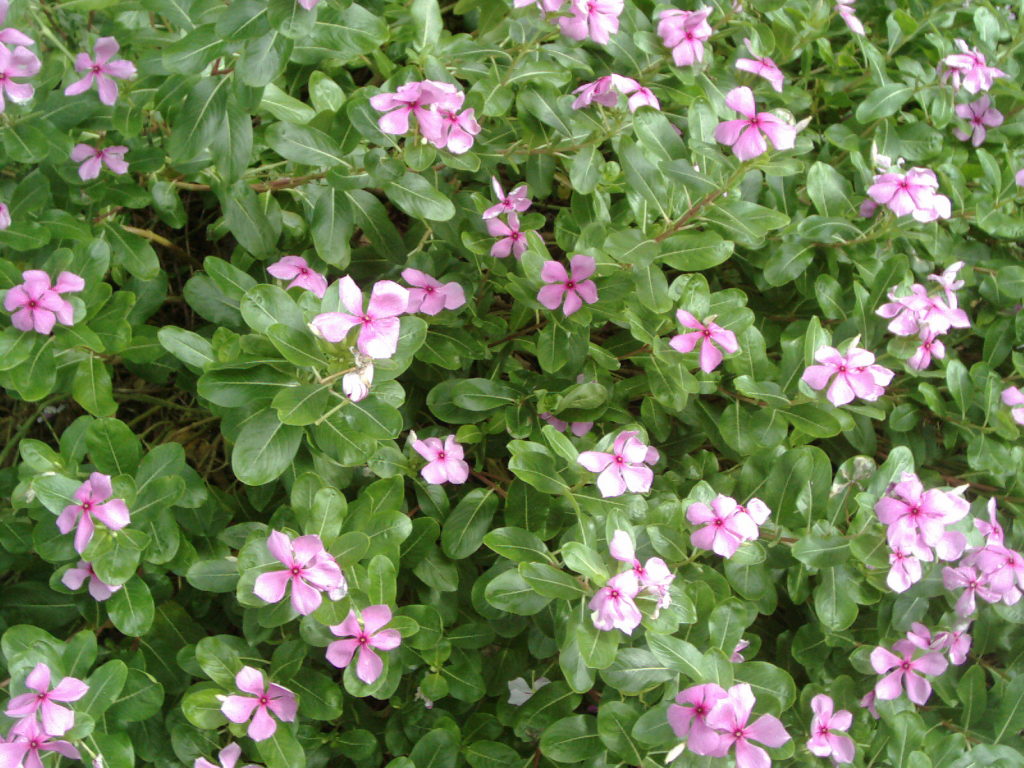When the summer heat arrives, and the flowers planted for color in the cool weather fade quickly, planting flowers in the garden or landscape can be tricky. There are heat-loving selections for color all summer long in warm-season gardens. One of my favorites is the old-fashioned periwinkle, also known as vinca or the scientific name Catharanthus roseus. Periwinkles provide excellent color and are drought tolerant too.

Periwinkle is native to Madagascar and India but has naturalized in the tropics worldwide. Grown as an annual in mostly, where the weather is warm, it is a short-lived perennial. Typically, periwinkle is evergreen, herbaceous, though it can turn woody with age. The leaves are shiny, opposite, oblong, and 1-2 inches long. The singly borne flowers are tubular, spreading to show a 5-petal flower in shades of pink, lavender, coral, or white. The stems can be brittle, and the plant is variable in form – upright, mounding, or spreading, depending on the variety.
Periwinkle is toxic when ingested. It contains many poisonous and beneficial alkaloids and has been known to poison cattle. Catharanthus has been used to treat asthma, diabetes, high blood pressure, and constipation in the past. Research has currently indicated that substances from Catharanthus may be effective in treating various forms of breast cancer, skin cancer, lymphoma, leukemia, and Hodgkin’s disease.
In the past, this was known as an amazingly easy to grow plant that survived sub-tropical and tropical conditions. Recently many growers, landscapers, and gardeners experienced problems growing periwinkle. Once installed, the young plants would show signs of blight. Dark splotches, streaks, or spots would appear on the stems and leaves, the leaves would wilt, sections of the plant would turn gray. Eventually, a part of the plant or the whole plant would die. The cause of this blight is a seed-borne fungus known as aerial Phytophthora.
The good news is plant breeding and selection has found and developed varieties with resistance to Phytophthora and several other diseases. The Cora ™ and Nirvana™ series show good disease resistance in comparison to older varieties.
Even when using the newer disease-resistant plants, there are some tactics for managing the fungus and disease. Periwinkle, once established, is a beautiful plant for summer gardens. To grow healthy plants, choose a location with full sun, at least 6 to 8 hours a day. The soil should be sandy and very well-drained. Unlike other annuals or bedding plants, mulch the bed to prevent soil from splashing on the leaves. Water new plants to help establish and then water periwinkle only if it is dry.
Other strategies to suppress aerial Phytophthora include planting with plenty of air space around young plants. Do not plant periwinkles in the same location year after year, avoid overhead irrigation, and prune infected tissue from plants as soon as symptoms are visible.
Once periwinkle is established and there is little chance of splashing soil, they should live for several years, barring excessively wet conditions. At maturity, many periwinkle varieties will reach a foot tall and wide; some types grow larger, some are trailing. Use this lovely summer flower as a bedding plant, in containers, as a ground cover, or in borders. Again, irrigate only to establish and then cut the water off.
This article first appeared in the Treasure Coast Newspapers.
Leave a Reply